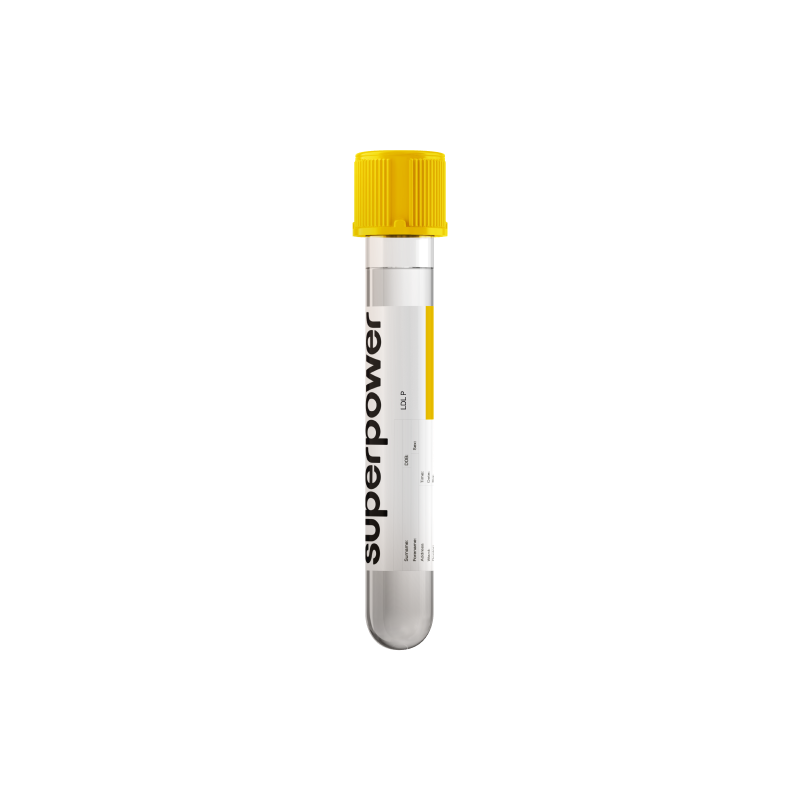LDL-P (low-density lipoprotein particle number) counts the actual number of LDL particles moving through your bloodstream. Unlike LDL-C, which measures the cholesterol inside the particles, LDL-P reflects how many of those particles are present.
More particles mean more chances for cholesterol to enter the artery wall and form plaque, even if LDL-C looks “normal.”
Key Benefits
- See your artery-clogging particle load, beyond LDL cholesterol concentration alone.
- Spot hidden risk when LDL-C looks fine, by counting atherogenic LDL particles.
- Clarify risk in diabetes or high triglycerides, where LDL-C can underrepresent particle burden.
- Guide therapy decisions when LDL-C and particle number are discordant.
- Track response to lifestyle or medications by watching particle counts fall with treatment.
- Flag possible inherited lipid disorders when LDL particle number is markedly elevated.
- Best interpreted with apoB, non‑HDL‑C, triglycerides, and your overall cardiovascular risk.
What is LDL P?
LDL-P means low-density lipoprotein particle number. It is the count of LDL particles circulating in the blood. These particles are made as the liver packages fat and cholesterol into very-low-density lipoproteins (VLDL), which are trimmed down in the bloodstream to become LDL. Each LDL particle is a small lipid-protein carrier with a single structural protein called apolipoprotein B-100 (apoB-100). Because each LDL has one apoB, LDL-P closely tracks the total number of apoB-containing particles.
LDL particles ferry cholesterol to tissues. They bind to LDL receptors on cell surfaces, are taken into cells (receptor-mediated endocytosis), and deliver cholesterol for membrane building, hormone production, and other needs. LDL-P reflects how many of these cholesterol-carrying vehicles are present at any moment, and therefore how frequently cells—and the artery wall—encounter them. It is a particle count, not a measure of how much cholesterol is inside each particle. In that way, LDL-P complements LDL-C by focusing on the number of carriers rather than the cargo mass within them.
Why is LDL P important?
LDL P (LDL particle number) counts how many LDL carriers are circulating, not how much cholesterol they hold. It matters because each particle can enter artery walls, trigger inflammation, and build plaque—affecting blood flow to the heart, brain, kidneys, and limbs. More particles mean more “traffic” pressing on the endothelium, raising atherosclerosis risk even when cholesterol concentration looks “normal.”
Many labs mark the optimal range toward the low end; values below about 1,000 are typically considered optimal, borderline in the low 1,000s, and high above about 1,600. When LDL cholesterol and LDL P disagree, particle number tracks cardiovascular risk more closely.
When values are low, the body is moving fewer atherogenic particles. This eases endothelial stress, slows plaque formation, and is usually symptom-free. Very low values can reflect genetic hypobetalipoproteinemia or states like malabsorption or hyperthyroidism, sometimes accompanied by weight loss, fatigue, or fat‑soluble vitamin deficits. Children often have lower levels than adults; premenopausal women tend to run lower than men.
When values are high, there are many artery‑entering particles—large or small—driving plaque growth and instability. This is common with insulin resistance, metabolic syndrome, kidney disease, and familial hypercholesterolemia; levels rise after menopause and increase physiologically during pregnancy. Symptoms are often silent until angina, claudication, TIA, or infarction occur.
Big picture: LDL P captures the actual load of atherogenic lipoproteins and integrates with apoB, non‑HDL cholesterol, triglycerides, glucose/insulin status, thyroid and kidney function, and inflammation. Over time, higher particle counts translate into higher atherosclerotic cardiovascular disease risk.
What Insights Will I Get?
LDL-P measures the number of LDL particles circulating in your blood, not the cholesterol content inside them. These ApoB-containing particles deliver cholesterol and other lipids for cell membranes, steroid hormone synthesis, myelin, and immune function. System-wide, more particles create more chances for arterial wall retention and plaque formation, a core process in atherosclerosis, independent of LDL cholesterol concentration.
Low values usually reflect fewer ApoB-containing particles in circulation. This can occur with reduced liver lipoprotein production, too much thyroid hormone (hyperthyroidism), malnutrition, chronic inflammation or advanced liver disease, or certain genetic variants. At modestly low levels, lipid delivery is typically adequate; at very low levels, it can track with catabolic states and reduced transport of fat‑soluble molecules. In pregnancy and in childhood, unusually low LDL-P is uncommon and may suggest illness rather than normal physiology.
Being in range suggests balanced lipid transport with a lower atherogenic particle burden, supporting stable cardiovascular, cognitive, and endocrine function. For long-term cardiovascular risk, optimal tends to sit toward the lower end of typical laboratory ranges when considered with the rest of the lipid profile.
High values usually reflect an excess of circulating atherogenic particles. Common drivers include insulin resistance and metabolic syndrome, type 2 diabetes, too little thyroid hormone (hypothyroidism), nephrotic syndrome, obesity, late pregnancy, and genetic dyslipidemias such as familial hypercholesterolemia or familial combined hyperlipidemia. Men often run higher than premenopausal women; levels rise with age and after menopause. In youth, very high values raise suspicion for a genetic cause.
Notes: LDL-P closely tracks apolipoprotein B (one ApoB per particle), and either can index atherogenic particle number. Nonfasting samples are acceptable. Acute illness can transiently lower values. Methods (e.g., NMR vs immunoassay) and reference ranges differ by lab.



.svg)



.png)
.png)
.png)
.png)








